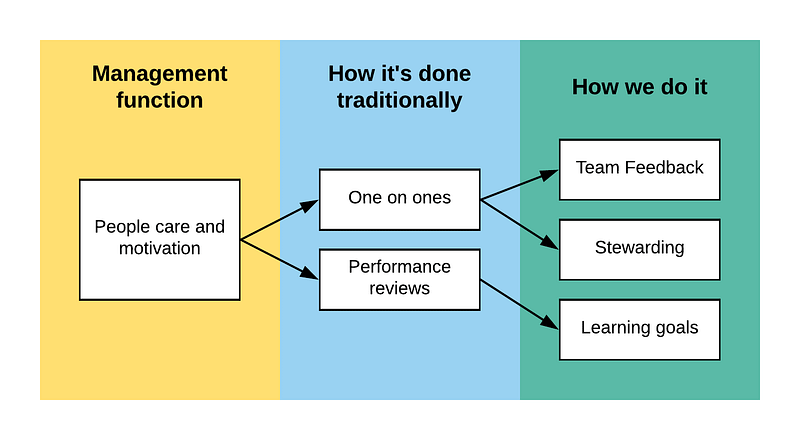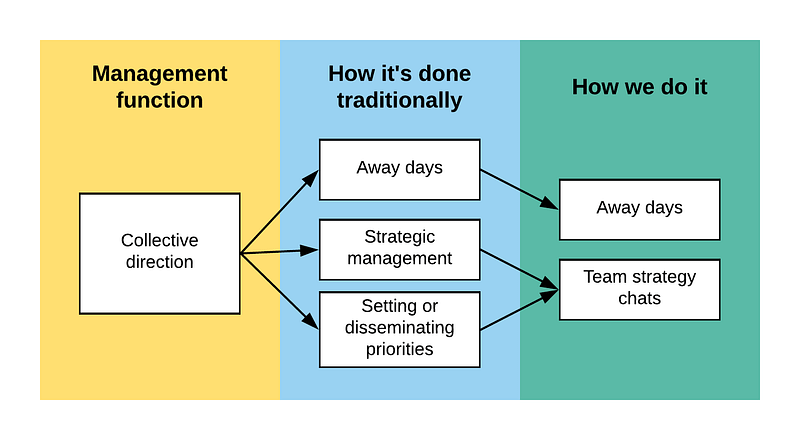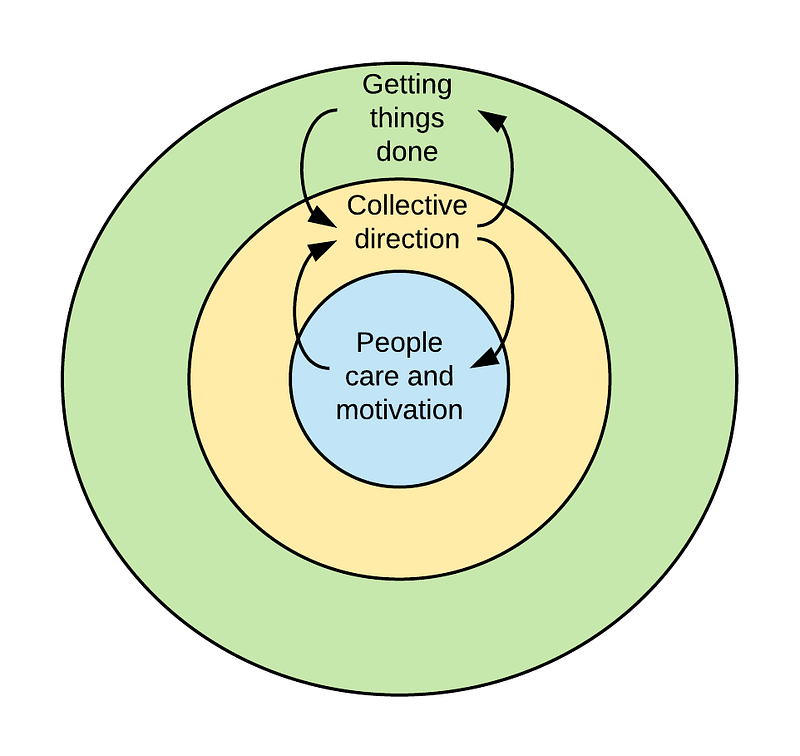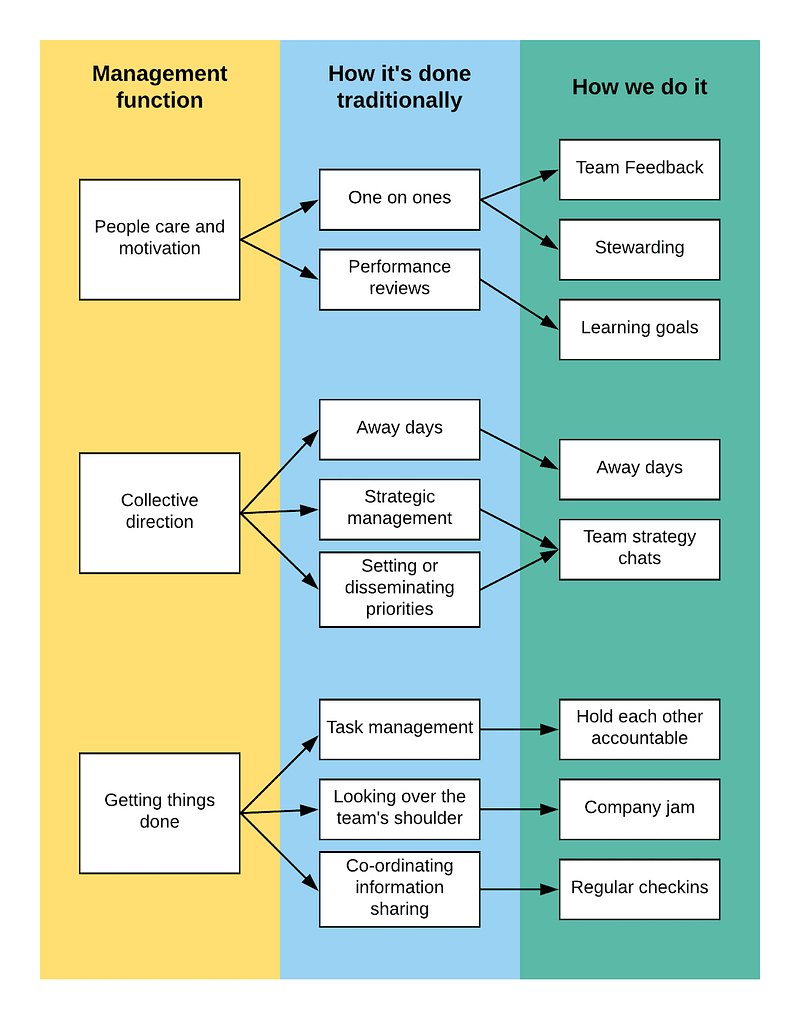By Rupert Snook from Optimi and originally published at Enspiral Tales on medium.com
As a self-managing company with a flat structure, we’ve got plenty to learn from looking at traditional management styles. While we’re not interested in top-down hierarchical management at Optimi, we’ve found inspiration in tradition.
A good traditional manager can look into the future, inspire everyone, make clear decisions, ensure work gets done, take care of people… and more.
So how can we apply those good things to our work as a self-managing team? This blog tells the story of how we’re co-opting management skills for our self-management practice, and what we’re learning along the way.
People care and motivation
He aha te mea nui o te ao. He tāngata, he tāngata, he tāngata!
What is the most important thing in the world? It is people, it is people, it is people!
Excerpt from a well known whakataukī (Māori proverb)

Our people are where it all begins. We, as individual humans, are at the centre of our team self-management practice. Our personal growth and inspiration is very important to us, so we’ve evolved some great people care practices inspired by the tradition of managerial one on ones.
Management practice: One on ones
“One on ones” are a common management institution. They’re meetings to focus on the individual, to review performance and give specific feedback. We like this practice of feedback at Optimi, but we do it as a team of three instead of one on one. For us, having more than two people in the room adds a lot of richness. Not only do we each get to give and receive feedback — but we can learn from watching each other give and receive feedback as well.
Traditional one on ones can also be about pastoral care — managers caring for their staff. At Optimi, we have something similar, except it’s a peer-to-peer pastoral care system. It’s called stewarding, which is an Enspiral practice (see this link for more info). Our peer-to-peer stewarding means that every member of the team gets supported, and each member of the team has someone to support. Malcolm stewards Charley, Charley stewards Rupert, and Rupert stewards Malcolm. This practice means we all get the opportunity to build our stewardship skills, and be cared for at the same time!
Management practice: performance reviews
As for performance reviews, we’ve replaced them. Instead, we get together as a team to define our individual learning goals. We think performance reviews emphasise thinking about the past. However, setting learning goals orientates people toward the future. We’ve discovered that replacing performance measurement with a future-focussed learning mindset really helps us to grow as a team!
Collective direction

Management practice: away days
Away days are common in traditional companies, and we have away days too. Just like many traditionally managed teams, we get together regularly each quarter to talk about the big picture. For us, talking about the big picture means discussing our direction and our long term goals. It’s quite similar to the corporate away day, except for the fact that as a non-hierarchical team, we each have input into our company strategy. This means that our strategic decisions are based on the strongest ideas in the room (not the highest paid person’s opinion).
Management practice: setting priorities
Once we’ve solidified our vision and mission at an away day, the next step is to make sure that our actual work is aligned to our strategy. Instead of relying on a traditional manager to keep the strategy in their head and delegate priorities, we all take collective responsibility for achieving our strategy. We meet regularly for “team strategy chats” where we evaluate how well our strategic goals are being achieved. This meeting is based on two questions:
- Are we on track to achieve our long term vision?
- Are we accountable to the achievements we’ve committed to at the away day?
Strategic management vs involving everyone
We talked about setting learning goals earlier —
and it turns out that learning goals are a key input for our collective direction.
Our learning goals as individuals add flavour to our collective vision and mission for the company. For example, one of us might be interested in learning more about the UN’s sustainable development goals. As an organisation, we might then decide that we want to apply that learning more broadly, and make sustainable development goals an important part of our strategy or long term vision.
Getting things done

Management practice: task management
Traditionally, managers take care of task coordination and ensuring things get done. They tend to exclusively hold the high level plan vision. A manager might start with a vision and break it down into separate tasks. Then they allocate tasks to the people they are managing, and they follow up regularly with their staff to check on progress.
Instead of needing regular follow up from a manager, we rely on holding each other accountable to getting work done. We have roles and accountability questions to help with this. If there’s work to do, we figure out which role is accountable, and then use a simple question process to bring that accountability to life. We’ve written more about the question process here.
Management practice: coordinating and information sharing
Even though our self-managing team works with high trust and lots of information sharing, we still need coordination on some things. Mostly we need to coordinate the work we do on ourselves as a company. Budgets, agreements, HR concerns, product development chats, retrospecting on how we’re working together… you name it. We get together regularly for a “company jam” where we either do this work together, or talk about how we’re going to approach it as individuals. This means that we don’t duplicate work and we’re well coordinated as a team… without needing someone to explicitly coordinate for us!
To complete the coordination loop, we surface information regularly with daily written “check ins” on our team communications channel. For us, a check in can cover a range of things. The classic Scrum standup questions are often referenced, but we’ve also learned that there’s lots of other great areas to talk about. Personal wellbeing, strategic thoughts, culture and process observations, and musings on the world are all great topics to cover.
How it all hangs together
One of the most interesting learnings of our journey has been seeing how these practices all relate to each other.
- Our people are at the heart of a self-management practice. We work on knowing what our people need and what they want to learn, which feeds into…
- Our collective direction. Individual goals influence where we go as a team. And our collective direction influences…
- Our day-to-day work where we get things done. Getting things done helps us achieve…
- Our goals for our collective direction. And achieving things as a group…
- Serves us as individual people. So we’re back to the heart of our self-management practice — the people!

A thought about collective ownership
There’s something underneath all the practices that we’ve talked about here — something that gives us real commitment to our success as a self-managing team. That something is collective ownership.
When we all own the company, it has a subtle but important effect on our psychology.
It’s a feeling that we are growing our own livelihoods through our actions as a team — we don’t just wait to be told what to do by a manager.
We have a hypothesis that collective ownership really helps with self-management. If your people don’t own the company, we suspect that’ll place a limit on how much they can truly be self-managing.
Summary

As a self-managing company with a flat structure, this is how we’re inspired by the traditional management techniques that are often used in hierarchical companies. Even though traditional management styles don’t work well at Optimi, we’ve found that management skills are something we can all use. This is our way of getting all the good juice out of proven management practices — without all the unpleasant power dynamics! We hope you can find something useful in the world of tradition too.
There’s lots of great articles about self-management and leadership in Enspiral Tales. We recommend looking at these next:




